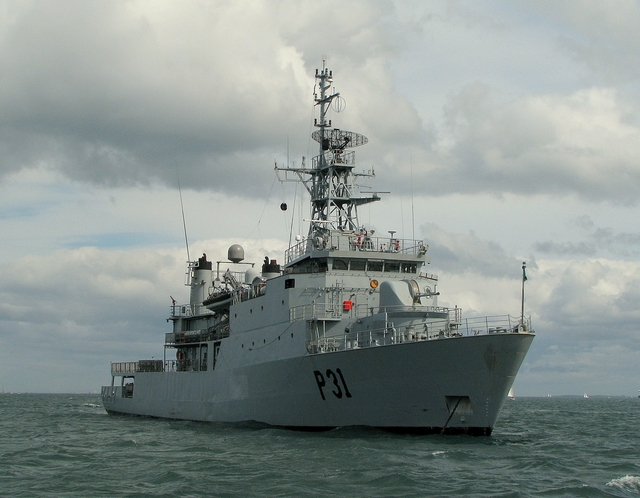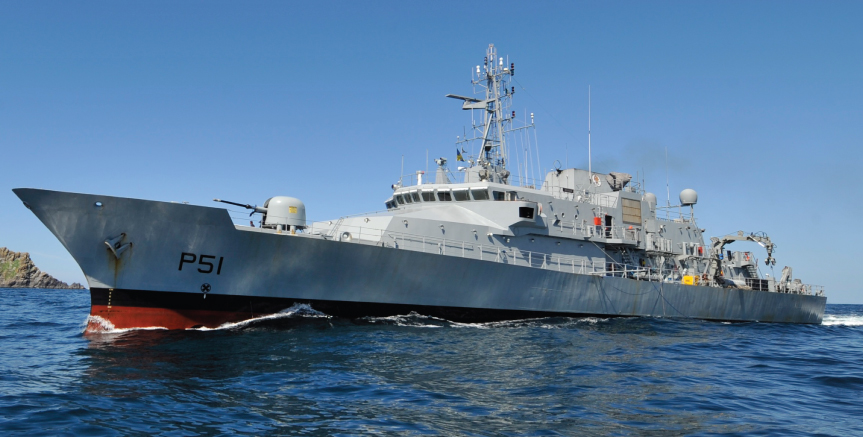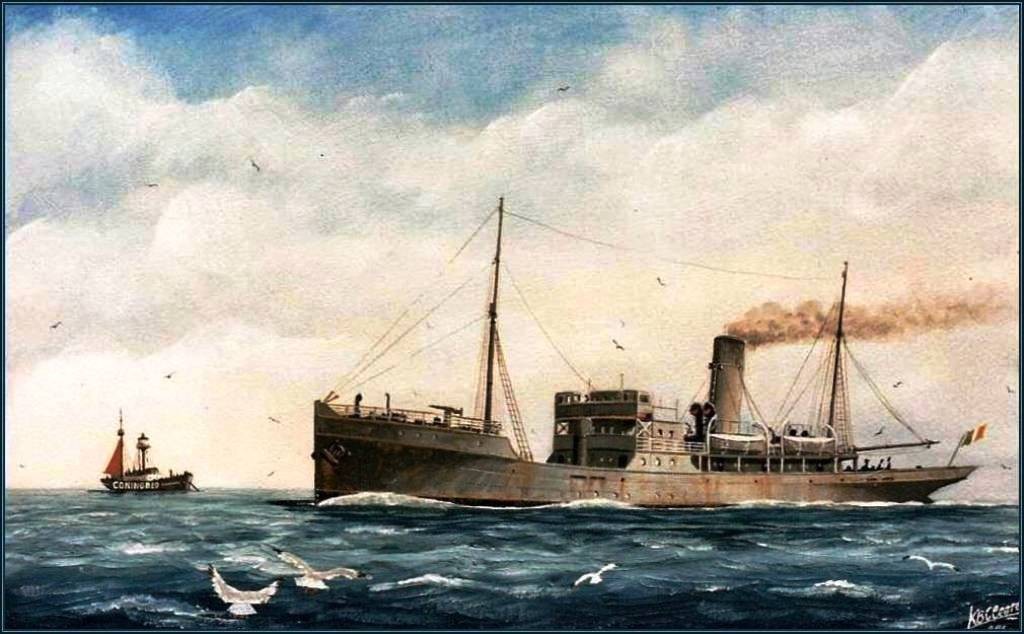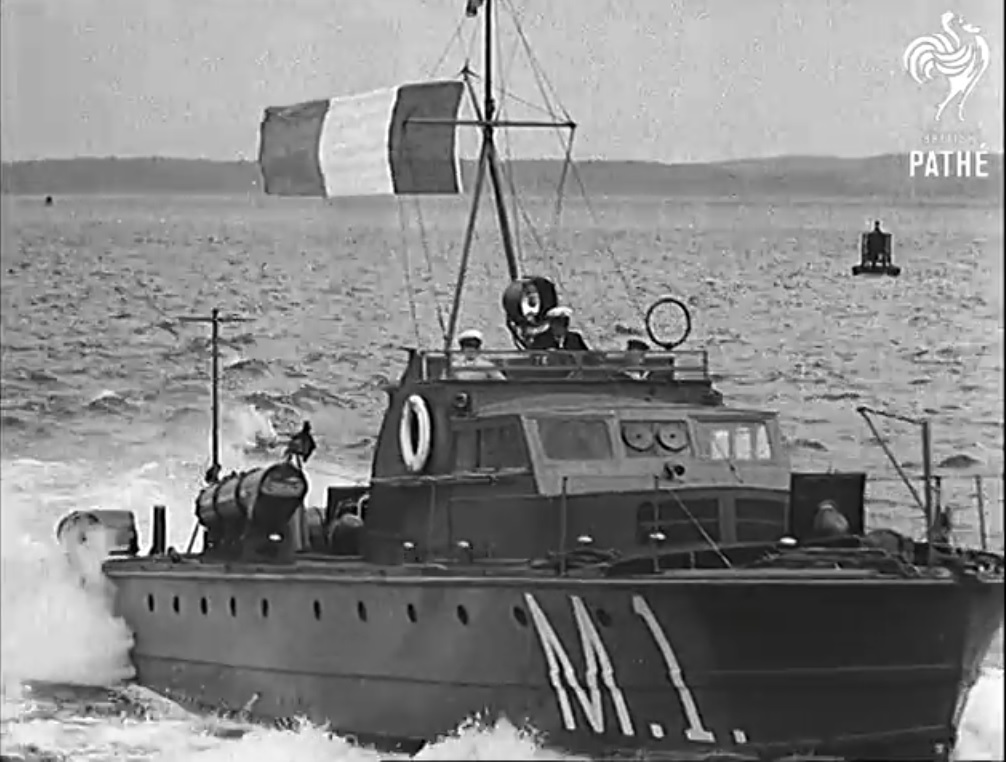1922: The Irish Naval service
The Anglo-Irish treaty of 1922 stipulated that for maritime affairs, Ireland must police its own customs and fishing areas, whereas the Royal Navy would take charge of Irish waters. The year after, the Irish coastal and Marine service was created, disbanded in 1924. A single ship was used at that time, Muirchù, requisitioned to take care of fisheries. It was only armed in 1936 with a single 3-in gun. In 1938 however, the Royal Navy retired from Cork, Bere Haven and Lough Swilly, handing over these to the Irish Republic. Soon, the steamer Fort Rannich was armed too and joined the Muichù. To help them, two faster 60 ft Motor TBs were ordered from Vosper Thornycroft.
The Irish Marine & Coastwatching service in WW2
When the war broke up, Ireland remained neutral. However the climate eased a bit compared to WW1 and the Germans could no longer use the local rebellion to divert attention and troops, although this was a landing point for some spies and double agents. Quite the contrary, many Irishmen volunteered to fight for the Empire. In June 1940, the tiny Irish Navy took its share of operations at Dunkirk: A single MTB, M1 made two trips to evacuate troops from the pocket. Soon the government found those valuable and ordered four more. In total in December 1940, the Irish fleet had six MTBs for patrols and two auxiliaries used as fishery protection vessels. These six crafts totalled twelve torpedoes, a deterrent for any approaching ship from the coast.
The Irish service regulated merchant traffic (notably the Irish merchant fleet), contributing to ease the threat of U-Boats, and protect fisheries. Also minefields were laid in front of Cork and Waterford. The navy was renamed “Irish Marine Service” and in 1942, two more MTBs were obtained, so eight in total. Irish cargo ships sailed with full navigation lights due to Irish neutrality. Large tricolor bands were painted on their hull with the mention “EIRE” on their sides and decks.
However allied convoys passed nearby and had orders to not stop to rescue survivors of a ship torpedoed. Irish ships therefore often stopped. They rescued in total more than 500 seamen, and airmen from many nations. Nevertheless over 20% of Irish seamen lost their lives in attacks from U-Boats and aviation.
The Irish Defence Force in the cold war
Although modest by EU standard, the Irish Navy during the cold war was reformed again in 1946 as the “Irish Defence Forces”. Incorporated into the Commonwealth until 1948 and then independent, the Republic of Ireland (1949) still possessed a 8-MTB strong coastal force capable of enforcing fishing zones and territorial waters, composed exclusively of patrol boats. Ireland’s neutrality prevented the country to join NATO.
Originally, Ireland operated three former flower-class Corvettes, well adapted to Irish waters (Cliona, Macha, Maev), and retired in 1971-72. They had been modernized in 1953, becoming fishery protection vessels. There was also still active the old patrol boat (1936) Fort Brannoch, and 5 British MTBs remaining in service until 1947-48. Soon, the Navy gained three Banba class minesweepers, of the “Ton” type, and built locally. They were Banba, Fola, and Gràinne, acquired in 1971 and disarmed in 1983-86.
All in all, the Irish navy operated 8 patrol boats at the time of the fall of the USSR. At present, its booming economic situation gives the government means for a much more ambitious naval policy, even though local needs do not require greater force than that currently deployed unless it engages in a more proactive foreign policy and interventionist, which does not seem to be his priority.
Strength in 1990:
-8 Patrollers:
The Deidre in 1984 was a kind of “prototype” series, which succeeded to the three older Emer class, built 1970-79. The “flagship” of the Irish navy as of today is still the LÉ Eithne, a 2,000-ton ship capable of operating a helicopter. In addition, Ireland ordered two fast Peacock class vessels in 1988, the Orla and Ciara, built in Hong Kong.
Patrol Sloop Eithne (1983)

LÉ Eithne (P31) at Tall Ships Belfast, 2009
Built-in Cork, launched in 1983, and commissioned in December 1984, this building was based on the Emer but redesigned for a longer range (more than 200 nautical miles). Two ships were initially planned, but only one approved for budgetary reasons. The armament was mixed (Swedish Bofors, German cannon, French electronics and Dauphin helicopter). The latter was a patrol and rescue craft, unarmed in principle.
Specifications
Displacement: 1915 tons PC.
Dimensions: 80.8 x 12 x 4.3 m.
Propulsion: 2 propellers, 2 Ruston paxman diesels, 7200 hp and 19 knots max.
Armament: 1 57 mm Bofors gun, 2 20 mm Rheinmetall, 2 ML 7.62 mm.
Electronics: Decca Radars TP1229, AC1629c, HSA DA-05, Sonar Plessey.
Crew: 82
Large infographic by D. Mitch (naval analyses) showing details about the Eithne

LÉ Róisín, commissioned in 1999, the most modern Irish warship, 1,500 tonnes, only gun-armed (Credit Irish Naval Service)
To come:
Cliona class patrol ships
Deidre/Emer class patrol ships
Orla class fast patrol boats
Le Roisin patrol corvette
Read More:
Conway’s all the world’s fighting ships 1906-1921 & 1922-46
//en.wikipedia.org/wiki/Irish_patrol_vessel_Muirch%C3%BA
wikiwand.com/en/Irish_Naval_Service
//coastmonkey.ie/irish-naval-service-anniversary-founding/
military.ie



 Latest Facebook Entry -
Latest Facebook Entry -  X(Tweeter) Naval Encyclopedia's deck archive
X(Tweeter) Naval Encyclopedia's deck archive Instagram (@navalencyc)
Instagram (@navalencyc)





 French Navy
French Navy Royal Navy
Royal Navy Russian Navy
Russian Navy Armada Espanola
Armada Espanola Austrian Navy
Austrian Navy K.u.K. Kriegsmarine
K.u.K. Kriegsmarine Dansk Marine
Dansk Marine Nautiko Hellenon
Nautiko Hellenon Koninklije Marine 1870
Koninklije Marine 1870 Marinha do Brasil
Marinha do Brasil Osmanlı Donanması
Osmanlı Donanması Marina Do Peru
Marina Do Peru Marinha do Portugal
Marinha do Portugal Regia Marina 1870
Regia Marina 1870 Nihhon Kaigun 1870
Nihhon Kaigun 1870 Preußische Marine 1870
Preußische Marine 1870 Russkiy Flot 1870
Russkiy Flot 1870 Svenska marinen
Svenska marinen Søværnet
Søværnet Union Navy
Union Navy Confederate Navy
Confederate Navy Armada de Argentina
Armada de Argentina Imperial Chinese Navy
Imperial Chinese Navy Marinha do Portugal
Marinha do Portugal Mexico
Mexico Kaiserliche Marine
Kaiserliche Marine 1898 US Navy
1898 US Navy Sovietskiy Flot
Sovietskiy Flot Royal Canadian Navy
Royal Canadian Navy Royal Australian Navy
Royal Australian Navy RNZN Fleet
RNZN Fleet Chinese Navy 1937
Chinese Navy 1937 Kriegsmarine
Kriegsmarine Chilean Navy
Chilean Navy Danish Navy
Danish Navy Finnish Navy
Finnish Navy Hellenic Navy
Hellenic Navy Polish Navy
Polish Navy Romanian Navy
Romanian Navy Turkish Navy
Turkish Navy Royal Yugoslav Navy
Royal Yugoslav Navy Royal Thai Navy
Royal Thai Navy Minor Navies
Minor Navies Albania
Albania Austria
Austria Belgium
Belgium Columbia
Columbia Costa Rica
Costa Rica Cuba
Cuba Czechoslovakia
Czechoslovakia Dominican Republic
Dominican Republic Haiti
Haiti Hungary
Hungary Honduras
Honduras Estonia
Estonia Iceland
Iceland Eire
Eire Equador
Equador Iran
Iran Iraq
Iraq Latvia
Latvia Liberia
Liberia Lithuania
Lithuania Mandchukuo
Mandchukuo Morocco
Morocco Nicaragua
Nicaragua Persia
Persia San Salvador
San Salvador Sarawak
Sarawak Uruguay
Uruguay Venezuela
Venezuela Zanzibar
Zanzibar Warsaw Pact Navies
Warsaw Pact Navies Bulgaria
Bulgaria Hungary
Hungary

 Bundesmarine
Bundesmarine Dutch Navy
Dutch Navy Hellenic Navy
Hellenic Navy Marina Militare
Marina Militare Yugoslav Navy
Yugoslav Navy Chinese Navy
Chinese Navy Indian Navy
Indian Navy Indonesian Navy
Indonesian Navy JMSDF
JMSDF North Korean Navy
North Korean Navy Pakistani Navy
Pakistani Navy Philippines Navy
Philippines Navy ROKN
ROKN Rep. of Singapore Navy
Rep. of Singapore Navy Taiwanese Navy
Taiwanese Navy IDF Navy
IDF Navy Saudi Navy
Saudi Navy Royal New Zealand Navy
Royal New Zealand Navy Egyptian Navy
Egyptian Navy South African Navy
South African Navy






























 Ukrainian Navy
Ukrainian Navy dbodesign
dbodesign